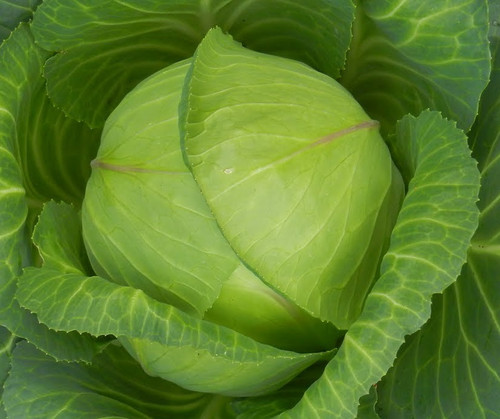Type: Open Pollinated/Heirloom
Relative Days: 70-95
Average Size: 6-10 lbs.
Shape: Flat Round
Color: Dark Green
Life Cycle: Annual
Characteristics:
Early Flat Dutch cabbage is an heirloom variety prized for its excellent heat tolerance and extra-sweet flavor. Well-suited for both warm southern climates and northern gardens, Early Flat Dutch forms large, pale green, nearly flat heads that average 2 to 4 pounds. It is an early season type and considered one of the best cabbages for storage.
Cabbage (Brassica oleracea var. capitata)
Cabbage is a cool-season vegetable suited to both spring and fall. It belongs to the cole crop family (Brassica oleracea), which includes broccoli, Brussels sprouts, cauliflower, collards, kale, and kohlrabi. The trick to growing cabbage is steady, uninterrupted growth. That means rich soil, plenty of water, and good fertilization.
Temperature
Cabbage and related brassicas are heavy feeders. They require fertile soils in a pH range of 6.5–7.5, supplied with consistent irrigation throughout the growing period.
- EARLY SPRING CROP: Mid-season and early varieties are used. Sow 2 seeds per cell in 50–72 cell plug flats, 3–4 seeds/in. in 20-row flats, or outdoor beds 1/4" deep. Seedlings should be ready to transplant in 4–6 weeks. Keep soil temperature over 75°F until germination, then reduce air temperature to about 60°F. Transplant outdoors 4–6 weeks after sowing, 12–18" apart in rows 18–36" apart. Cabbage prefers cooler growing temperatures, between 55–75°F, the optimum being 60–70°F, but will produce good crops under warmer, summer conditions.
- FALL CROP: Choose mid-season and storage varieties. Start seedlings as above in May and transplant to the garden in June–July. To ensure mature heads, seed the crop early in areas where heavy freezes occur early in fall.
- WINTER CROP: Successful cabbage crops can be grown in mild winters (rarely below 32°F). Transplants can be set out from September to February in these regions.
Direct Seeding & Spacing
Sow 3–4 seeds 12" apart, 1/2" deep, rows 24–36" apart, thinning to one plant in each group.
Splitting
Early varieties may split or burst at maturity or from rapid new growth if rain or heavy irrigation follows a dry spell. Splitting may be partially avoided by slowing a plant's growth. To accomplish this, cultivate close to plants to sever some of the root system or slightly twist the plant.
Diseases
Adhere strictly to a preventive program including:
- Long crop rotations with non-cruciferous crops
- Clean starting mixes and outdoor seedbeds
- Strict sanitation practices
Harvest and Storage
Relatively young heads (still green and actively growing) store best. Ideal conditions are 32°F, at 95–98% relative humidity, with good air circulation. Store heads that are disease-free. From cool weather, spring transplanting, subtract 10–14 days for late spring or early summer, warm weather transplanting. Add about 14 days for direct seeding.
For more information, please see links below:
- Cornell University - Cabbage Production
- Michigan State University - Cabbage Caterpillar Thresholds
- University of Georgia - Cabbage Production
Downloadable Copy:
Please click here to download a printable version.


